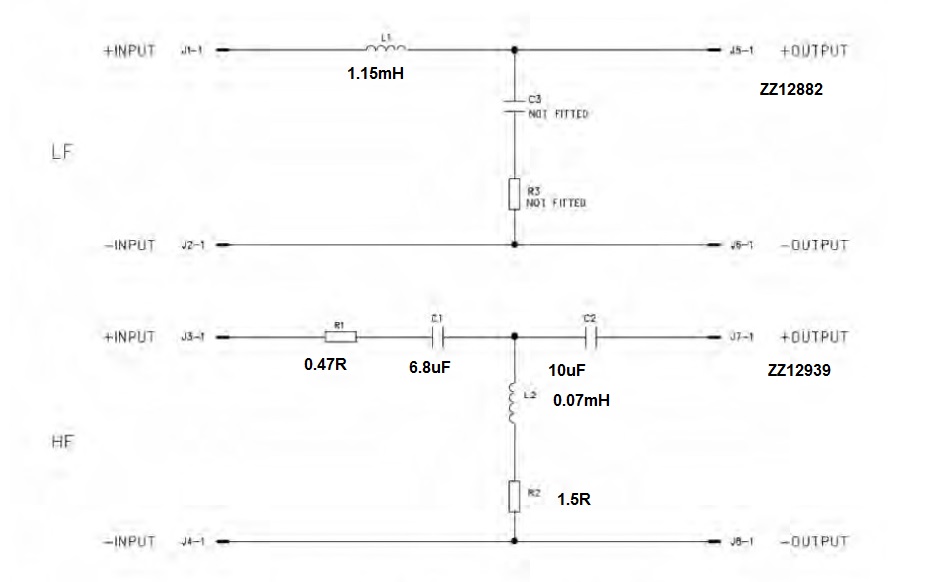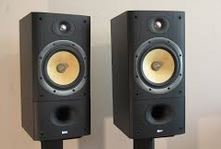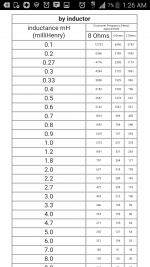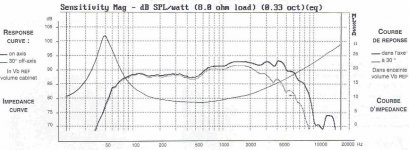My multimeter gives wrong values if it's not set to the appropriate scale. And you sometimes don't get a good metal connection to the probes.
If all is well, you will also measure about 4-5 ohms dc across the speaker plugs on the back of the cabinet.
But I think we are good to go, here. Do you have a pair of these speakers? Just wondering.
If all is well, you will also measure about 4-5 ohms dc across the speaker plugs on the back of the cabinet.
But I think we are good to go, here. Do you have a pair of these speakers? Just wondering.
yes i have 2 of them. i run them in stereo. had other 600 series. found these to be best for my use.
not huge towers. and these have some mid range. dm602 s3 had almost no midrange.
and i use bw800 series sub. 800asw ported.
woofers are 8.8ohm now) i left multimeter in the car. freezing temperatures. maybe thats the reason readings dont match with stamped ohm values
not huge towers. and these have some mid range. dm602 s3 had almost no midrange.
and i use bw800 series sub. 800asw ported.
woofers are 8.8ohm now) i left multimeter in the car. freezing temperatures. maybe thats the reason readings dont match with stamped ohm values
Last edited:
I dug up an old thread on the DM602 s3:
http://www.diyaudio.com/forums/multi-way/268109-tweeter-replacement-b-w-dm602-s3s.html


Seen one B&W crossover, seen 'em all, eh? But it suggests that 0.7mH won't be bad into twin drivers.
http://www.diyaudio.com/forums/multi-way/268109-tweeter-replacement-b-w-dm602-s3s.html


Seen one B&W crossover, seen 'em all, eh? But it suggests that 0.7mH won't be bad into twin drivers.
hm.. yes at one point i had 4 pairs of 602 s3) yes tweeters were very bright. actually it's not the brightness but there was one nasty pick in them that made them unbearable especially if you have yamaha amp. lcr600s3 and lcr60 s3 use a different tweeter.. magnetically shielded. it sounds much smoother. more natural. thats one reason i decided to keep lcr600. another reason dm602 don't seem to have much control of the bass. boombox kind of sound. and no midrange. just absent. well i am soldering now. we will see what the result will be.
really appreciate your time. never thought there is a place like diyaudio))
really appreciate your time. never thought there is a place like diyaudio))
I have heard these DM602. Bit bright and a bit of cone breakup, I thought.
People buy boom and tizz! But I can't fault the tweeter filter.
You can tame a metal tweeter with a Zobel network around 7.5R/0.68uF across the tweeter. Take the level down to with a resistor. You can also buy fresh ferrofluid at Parts Express in the US and Blue Aran in the UK.
I really must get my SEAS metal tweeters back into action. Better than soft domes IMO.
People buy boom and tizz! But I can't fault the tweeter filter.
You can tame a metal tweeter with a Zobel network around 7.5R/0.68uF across the tweeter. Take the level down to with a resistor. You can also buy fresh ferrofluid at Parts Express in the US and Blue Aran in the UK.
I really must get my SEAS metal tweeters back into action. Better than soft domes IMO.
Well good thing nothing blew. it's a 5.7-6 ohm speaker now. too early to tell. i just shorted one inductance coil. i might integrate a switch in the back that will allow switching from stock to modded cross overs. were kind of hard to remove. small space.
sound wise... much cleaner. there is no muddy bass all over.
much better instrument separation. sharper rendition.. will post update after some time. did not bring them up to louder levels today..
glad this little project worked out) taming of tweeters on BW may be something many would like to do) depending on amp of course
sound wise... much cleaner. there is no muddy bass all over.
much better instrument separation. sharper rendition.. will post update after some time. did not bring them up to louder levels today..
glad this little project worked out) taming of tweeters on BW may be something many would like to do) depending on amp of course
Last edited by a moderator:
So glad you mentioned kevlar cone break up)
Read about it a little.
So dm602 s3 is often an example of kevlar woofer break up in various forums I've been.
It's low pass filter is 1.15 mH inductance coil. Pretty sure
It's a 6.5 or 7" woofer. Pretty big. 8 ohm resistance.
According to specs cross over is at 4000hz..
Now
on lcr600 s3 a .7mH coil is used.
Smaller woofer. 6" I believe.
Resistance of each is 8ohm. Or 4ohm of 2 of them in parallel. Same 4000hz cross over point.
Looking at chart attached it seems that lcr600 s3 (4ohm parallel set up) low pass filter is at around 900hz.
Dm602 s3 (8ohm) low pass filter is at around 1100hz.
Basically much lower chance of kevlar break up on lcr600 s3. Am I thinking right?
Read about it a little.
So dm602 s3 is often an example of kevlar woofer break up in various forums I've been.
It's low pass filter is 1.15 mH inductance coil. Pretty sure
It's a 6.5 or 7" woofer. Pretty big. 8 ohm resistance.
According to specs cross over is at 4000hz..
Now
on lcr600 s3 a .7mH coil is used.
Smaller woofer. 6" I believe.
Resistance of each is 8ohm. Or 4ohm of 2 of them in parallel. Same 4000hz cross over point.
Looking at chart attached it seems that lcr600 s3 (4ohm parallel set up) low pass filter is at around 900hz.
Dm602 s3 (8ohm) low pass filter is at around 1100hz.
Basically much lower chance of kevlar break up on lcr600 s3. Am I thinking right?
Attachments
Lynn Olson, he of beyond the Ariel, is good on this topic:
The Art of Speaker Design, Part II
I just looked up a typical Kevlar driver. The Audax HT170K0. Looks easy enough to filter with a simple coil for about 4kHz crossover. But some breakup at 4-5kHz there. I'd want to get it 10dB down at 5kHz with a third order filter. 6" speakers have other issues too. Mostly poor time-alignment.
The Art of Speaker Design, Part II
At present, though, even the best Kevlar, carbon-fiber, or aluminum cones show at least one high-Q peak at the top of the working range, requiring a sharp crossover, a notch filter, or both to control the peak. Unfortunately, this peak usually falls in a region between 3 and 5 kHz, right where the ear is most sensitive to resonant coloration.
Most audiophiles and magazine reviewers are unaware of the sonic signature of Kevlar or carbon-fiber resonance, misidentifying it as "amplifier sensitivity," "room sensitivity," or other problems that point away from the real culprit. Since few reviewers have auditioned the raw, unmodified sound of commonly-used drivers, they can’t evaluate how much "Kevlar sound," or "aluminum sound," remains as a residue in the finished design. It is the task of the designer to skillfully manage the crossover and cabinet profile to minimize the driver coloration. Despite advertising claims or the opinions of nationally famous reviewers, the characteristic signature of a driver can never be removed completely.
When working with rigid-cone drivers, there are some hard choices to make: if you lower the crossover frequency to minimize driver coloration, tweeter IM distortion skyrockets, resulting in raspy, distorted high frequencies at mid-to-high listening levels; if you raise the crossover frequency to improve the sound of the tweeter, the rigid-driver breakup creeps in, resulting in a forward, aggressive sound at moderate listening levels, and complete breakup at high levels. (Unlike paper cones, Kevlar, metal, and carbon fibers do not go into gradual breakup.) With the drivers we have today, the best all-around compromise is a 2nd, 3rd, or 4th-order (12-24dB/Oct.) crossover with an additional notch filter tuned to remove the most significant HF resonance of the midbass driver.
I should add, by the way, that I like Kevlar and aluminum drivers very much ... but no question about it, they are very difficult drivers to work with, with strong resonant signatures that must be controlled acoustically and electrically.
I just looked up a typical Kevlar driver. The Audax HT170K0. Looks easy enough to filter with a simple coil for about 4kHz crossover. But some breakup at 4-5kHz there. I'd want to get it 10dB down at 5kHz with a third order filter. 6" speakers have other issues too. Mostly poor time-alignment.
Attachments
Steve thanks again for your help.. ) invaluable help)
very informative thread for me in many ways.
I Had a pair Of lcr600 s3 for some time. Always tried various ways to remove extra fog of bass.
All resolved ) now if bass is the recording it will be reproduced. If it's not there there won't be extra bass coating of other instruments, voices.
very informative thread for me in many ways.
I Had a pair Of lcr600 s3 for some time. Always tried various ways to remove extra fog of bass.
All resolved ) now if bass is the recording it will be reproduced. If it's not there there won't be extra bass coating of other instruments, voices.
Richard, I've enjoyed this thread and your rare willingness to roll your sleeves up and try stuff. But I want to know how it turned out! Maybe some issue with tweeter level, after the mod, but I really don't know.
IMO, the B&W is a correctly designed 2.5 centre (voice) speaker, but a a poor and boomy stereo one.
MTM is a much better idea, since it projects well, and theoretically is more efficient and less distorting. We hear all this stuff about how MTM has a combing problem. Well, it never bothers me. I have an oldish Mordaunt Short MTM centre speaker. I wish I could find a second one in the junk shops. It's very good.
IMO, the B&W is a correctly designed 2.5 centre (voice) speaker, but a a poor and boomy stereo one.
MTM is a much better idea, since it projects well, and theoretically is more efficient and less distorting. We hear all this stuff about how MTM has a combing problem. Well, it never bothers me. I have an oldish Mordaunt Short MTM centre speaker. I wish I could find a second one in the junk shops. It's very good.
Richard, I've enjoyed this thread and your rare willingness to roll your sleeves up and try stuff. But I want to know how it turned out! Maybe some issue with tweeter level, after the mod, but I really don't know.
IMO, the B&W is a correctly designed 2.5 centre (voice) speaker, but a a poor and boomy stereo one.
MTM is a much better idea, since it projects well, and theoretically is more efficient and less distorting. We hear all this stuff about how MTM has a combing problem. Well, it never bothers me. I have an oldish Mordaunt Short MTM centre speaker. I wish I could find a second one in the junk shops. It's very good.
I am happy with this mod. Of course I can't measure resistance of speakers at various frequencies. Maybe it dips to like 1ohm. But i have yamaha mx1. Rare amp That handle super low impedances. Does not even run warm. It ran a barelly noticeably hotter with 4ohm speakers(vienna haydn) I doubt resistance is affected much.. 6ohm speakers now.
Yes the tweater sounds brighter now. Or more transparent id rather say. But nothing terrible. Without the sub bass maybe on thiner side ... if someone likes abundance of bass then this mod may not be good. Instruments, voices are much cleaner. Before things sounded bass heavy. LIke on a speaker where heavy bass driver extends to midrange response. Basically artificial bass. I was thinking of making a switch on the rear panel to allow switching back to stock. But now these speakers sound so much better That I think I'll skip this step. I did try equilizer before. I no doubt prefer the sound of these speakers over using an equilizer. Of course there are plenty of other nicer speakers) there is a slight droning or echo on upper mid frequencies. Like on Polk sda-crs.(great speakers btw) Kind of sounds like resonance. this is barely noticeable and only when comparing to other much more expwnsive speakers side by side. That resonance/echo effect was theRe before.
I suspect bw designed these speakers this way because most people use 7.1 receivers to run these.. and 90% of the time receiver does not have the juice to produce low end sufficiently. All in all its more "expensive" sound now) equilizer or toning bass down on pre amp could not remove that blanket of bass fog in mid range. It's gone now after this mod
Last edited:
i would honestly prefer midrange and tweeter of these speakers over 683 s2.. i am not sure why those are so popular. very very thin midrange and tweeters. with few serious peaks that made them unlistenable to my ear.
lcr600 s3 with this mod are great for new age music. very upfront sounding. now i have vienna beethoven(4500$speakers that can be found for 500$ used) should not compare 1000$ speakers to 4500$) very different animals) vienna has some softer tweeter material. but thats another novel describing how those sound. this seems to be a diy forum i noticed. i rarely see people fighting over whose sound is better. it's good to read stereophile.com scientific measurements of performance.. and listen. beethovens had few flaws on paper. but they sound superb. and actually i don't think stereophile.com measured older beethovens(2 midranges, 2 basses). only the newer baby beethoven, beethoven grand.
lcr600 s3 with this mod are great for new age music. very upfront sounding. now i have vienna beethoven(4500$speakers that can be found for 500$ used) should not compare 1000$ speakers to 4500$) very different animals) vienna has some softer tweeter material. but thats another novel describing how those sound. this seems to be a diy forum i noticed. i rarely see people fighting over whose sound is better. it's good to read stereophile.com scientific measurements of performance.. and listen. beethovens had few flaws on paper. but they sound superb. and actually i don't think stereophile.com measured older beethovens(2 midranges, 2 basses). only the newer baby beethoven, beethoven grand.
Last edited:
- Status
- This old topic is closed. If you want to reopen this topic, contact a moderator using the "Report Post" button.
- Home
- Loudspeakers
- Multi-Way
- tweaking / light touch up/ mod of BW LCR600 s3 speakers

